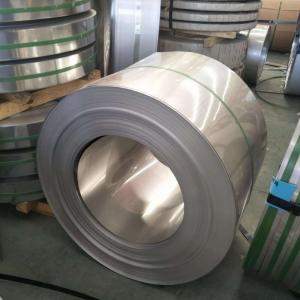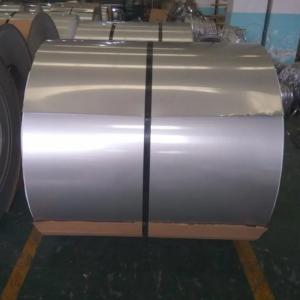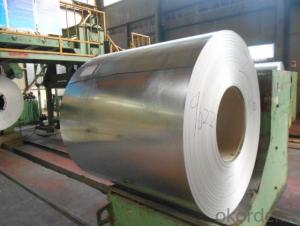Stainless Steel Coils for Carbin Building Decoration JIS EN ASTM AISI
- Loading Port:
- Shanghai
- Payment Terms:
- TT or LC
- Min Order Qty:
- 25 m.t.
- Supply Capability:
- 20000 m.t./month
OKorder Service Pledge
Quality Product, Order Online Tracking, Timely Delivery
OKorder Financial Service
Credit Rating, Credit Services, Credit Purchasing
You Might Also Like
Item specifice
Standard:
ASTM
Technique:
Cold Rolled
Shape:
Square
Surface Treatment:
Polished
Steel Grade:
300 Series
Certification:
SGS
Thickness:
1
Width:
1000
Length:
2000
Net Weight:
19
Stainless steel which can be produced in different chemical, physical and mechanical properties, have high corrosion and heat resistance, mechanical strength, manufacturing ease, aesthetic appearance hygienic and long lasting properties.
STANDARDS
ASTM A240/A240M,ASME A240/A240,EN 10088-2, EN10028-7,JIS G 4305
| Hot Rolled Stainless Steel Coil | |
| Size | Thickness 2.8mm-14mm, Width can be customized |
| Grade | SUS 201, 202, 304L/H, 316L/H, 321/H, 317/H, 347/H, 310S, 430, 409/L, 31803, 32750, 32760, etc |
| Standard | JIS,EN,ASTM,AISI |
| Finish | 1D, No.1 finish, black finish |
| Cold Rolled Stainless Steel Coil | |
| Size | Thickness 0.02mm-3mm, Width can be customized |
| Grade | SUS 201, 202, 304L/H, 316L/H, 321/H, 317/H, 347/H, 310S, 430, 409/L, 31803, 32750, 32760, etc |
| Standard | JIS,EN,ASTM,AISI |
| Finish | 2B, 2D, BA, NO.3, NO.4, SB, NO.8, HL |
| Application | Elevator, Carbin Decoration, Building Decoration, Architectural Decoration, Kitchen Decoration |

- Q:Are stainless steel sheets recyclable?
- Yes, stainless steel sheets are recyclable. Stainless steel is one of the most recyclable materials in the world, and its properties allow it to be recycled repeatedly without losing its quality or durability.
- Q:What are stainless steel sheets?
- Stainless steel sheets, which are composed of stainless steel, a type of alloy containing chromium, nickel, and other elements, are metal pieces that have a flat shape. These sheets possess exceptional resistance to corrosion, durability, and aesthetic appeal, which makes them highly versatile and extensively utilized in various industries. To achieve the desired thickness and finish, they undergo a manufacturing process known as hot rolling or cold rolling, where the steel is passed through a series of rollers. Stainless steel sheets find common applications in the construction, automotive manufacturing, kitchenware, appliances, and architecture sectors. They are available in different grades, surface finishes, and sizes to meet various requirements. Regardless of whether they are used for decorative purposes or functional applications, stainless steel sheets provide a dependable and enduring solution.
- Q:What is the maximum thickness available for stainless steel sheets?
- The maximum thickness available for stainless steel sheets can vary depending on the specific grade of stainless steel and the manufacturing capabilities of the supplier. However, in general, stainless steel sheets can be found in thicknesses ranging from 0.5mm to 80mm. It is important to note that thicker sheets are typically used for specialized applications that require increased strength and durability, such as construction projects or heavy machinery. When selecting stainless steel sheets, it is crucial to consider the intended use and consult with a reputable supplier to ensure that the desired thickness is available.
- Q:What are the different types of patterned finishes available for stainless steel sheets?
- Stainless steel sheets come in a variety of patterned finishes, each offering a unique aesthetic and functionality. Some of the most commonly used finishes include: 1. Diamond: This finish has a raised diamond-shaped texture on the surface, providing better grip and slip resistance. It is often used for flooring or industrial equipment. 2. Linen: The linen finish resembles woven fabric, adding a subtle elegance to stainless steel sheets. It is commonly used in interior design applications like wall cladding or decorative panels. 3. Checkered: This finish creates a checkerboard-like appearance with a grid of raised squares or rectangles. It adds visual interest and can give a retro or industrial look to stainless steel sheets. 4. Bead Blasted: In this finish, fine glass beads are blasted onto the surface to create a matte texture with a slightly rough surface. It is often used in architectural applications to provide a modern and uniform appearance while reducing glare and fingerprints. 5. Etched: This finish involves chemically altering the surface to create intricate patterns or designs. It can range from simple line patterns to complex images and is commonly used for decorative purposes like signage, artwork, or custom designs. 6. Sandblasted: Similar to bead blasting, sandblasting uses high-pressure sand or other abrasive materials to create a textured surface. It provides a rougher and more pronounced pattern, making it suitable for industrial or rugged applications. 7. Mirror: Although not technically a patterned finish, the mirror finish is highly popular for stainless steel sheets. It is achieved through a series of polishing and buffing processes, resulting in a highly reflective surface similar to a mirror. It is commonly used in architectural elements like cladding or decorative accents. In conclusion, the choice of patterned finish for stainless steel sheets depends on the desired aesthetic, functionality, and specific application requirements. Each finish offers a distinct look and texture, providing endless possibilities in design.
- Q:Can stainless steel sheets be used in the aerospace industry?
- Yes, stainless steel sheets can be used in the aerospace industry. Stainless steel is a versatile material that offers a high strength-to-weight ratio, corrosion resistance, and excellent mechanical properties, making it suitable for various aerospace applications. It is commonly used in the construction of aircraft components such as structural frames, engine parts, exhaust systems, and fuel tanks. Stainless steel sheets are also utilized in the production of aerospace fasteners, fittings, and interior cabin components. Its durability and resistance to temperature variations and extreme environments make it a reliable choice for the aerospace industry.
- Q:What are the common methods of cutting stainless steel sheets?
- There are several common methods of cutting stainless steel sheets, each with its own advantages and limitations. Here are a few commonly used methods: 1. Shearing: Shearing involves using a machine with two blades to slice through the stainless steel sheet. This method is suitable for thinner sheets and produces clean, straight cuts. However, it may leave a slight burr on the edge of the cut. 2. Plasma cutting: Plasma cutting is a versatile method that uses a high-temperature plasma arc to melt and blow away the metal. It is effective for cutting stainless steel sheets of various thicknesses and shapes. Plasma cutting provides fast, precise cuts and can handle both straight and curved lines. 3. Laser cutting: Laser cutting uses a focused laser beam to cut through stainless steel sheets. It is highly accurate and produces smooth, precise cuts with minimal distortion. Laser cutting is suitable for both thin and thick sheets, but it can be slower than other methods for thicker materials. 4. Waterjet cutting: Waterjet cutting involves using a high-pressure stream of water mixed with abrasive particles to cut through stainless steel. This method is precise and can handle various thicknesses and shapes. Waterjet cutting is known for its clean edges and the ability to cut without heat-affected zones. However, it may be slower than other methods and can be more expensive. 5. Sawing: Sawing is a traditional method that involves using a saw blade to cut through stainless steel sheets. It is suitable for thicker sheets and can handle both straight and curved cuts. Sawing produces relatively clean cuts but may result in more material waste compared to other methods. These are just a few of the common methods used to cut stainless steel sheets. The choice of method depends on factors such as the thickness of the sheet, desired cut quality, shape complexity, and budget. It is important to consider the specific requirements of the project and consult with professionals to determine the most suitable cutting method.
- Q:Can stainless steel sheets be used for pressure vessels?
- Yes, stainless steel sheets can be used for pressure vessels. Stainless steel is known for its excellent corrosion resistance, which makes it an ideal material for pressure vessels that are exposed to harsh environments or corrosive substances. It also has high strength and good mechanical properties, allowing it to withstand the internal pressure exerted by the fluid or gas inside the vessel. Additionally, stainless steel sheets can be easily formed and welded to create the desired shape and size of the pressure vessel. Overall, stainless steel sheets are a popular choice for pressure vessels in various industries such as oil and gas, chemical processing, and pharmaceuticals.
- Q:Can stainless steel sheets be used for bus shelters?
- Bus shelters can indeed utilize stainless steel sheets. This material, known for its durability and resistance to corrosion, proves ideal for outdoor structures such as bus shelters. Come rain, snow, or UV rays, stainless steel withstands diverse weather conditions without succumbing to deterioration or rust. Moreover, the sleek and contemporary look provided by stainless steel sheets enhances the overall visual allure of the bus shelter. Furthermore, the ease with which stainless steel can be cleaned and maintained guarantees the long-lasting nature of the bus shelter.
- Q:Are stainless steel sheets suitable for medical equipment or devices?
- Yes, stainless steel sheets are suitable for medical equipment or devices. They possess excellent corrosion resistance, durability, and high strength, making them ideal for use in medical settings. Stainless steel is also easy to clean and maintain, which is crucial for maintaining a sterile environment.
- Q:Are stainless steel sheets resistant to abrasion?
- Stainless steel sheets, in general, exhibit resistance to abrasion. The notable strength and durability of stainless steel make it less susceptible to scratches and wear in comparison to alternative materials. Its smooth surface can endure friction and abrasion, rendering it suitable across diverse applications that necessitate resistance against scratches and wear. Nonetheless, it is crucial to acknowledge that the degree of resistance may differ depending on the specific grade and finish of the stainless steel employed.
1. Manufacturer Overview |
|
|---|---|
| Location | |
| Year Established | |
| Annual Output Value | |
| Main Markets | |
| Company Certifications | |
2. Manufacturer Certificates |
|
|---|---|
| a) Certification Name | |
| Range | |
| Reference | |
| Validity Period | |
3. Manufacturer Capability |
|
|---|---|
| a)Trade Capacity | |
| Nearest Port | |
| Export Percentage | |
| No.of Employees in Trade Department | |
| Language Spoken: | |
| b)Factory Information | |
| Factory Size: | |
| No. of Production Lines | |
| Contract Manufacturing | |
| Product Price Range | |
Send your message to us
Stainless Steel Coils for Carbin Building Decoration JIS EN ASTM AISI
- Loading Port:
- Shanghai
- Payment Terms:
- TT or LC
- Min Order Qty:
- 25 m.t.
- Supply Capability:
- 20000 m.t./month
OKorder Service Pledge
Quality Product, Order Online Tracking, Timely Delivery
OKorder Financial Service
Credit Rating, Credit Services, Credit Purchasing
Similar products
New products
Hot products
Related keywords





























